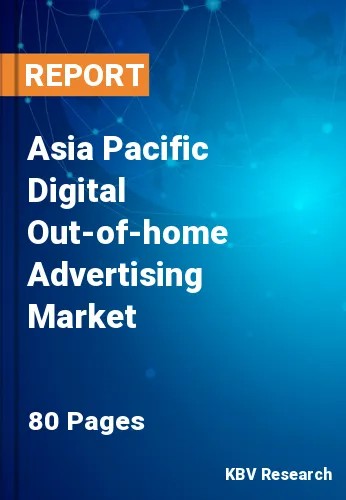The Asia Pacific Digital Out-of-home Advertising Market would witness market growth of 12.5% CAGR during the forecast period (2022-2028).
When it comes to selling advertising space on outdoor media networks, DOOH has a distinct advantage in that it supports programmatic platforms. Advertisers who use printed media must contact the network owner directly to discuss campaign details. Content is controlled by software with digital signage, making it much easier to maintain and adjust to client feedback. This enables programmatic advertising, in which a media buyer can search a network's inventory and book spots based on the demographics of their target audience. As a result, advertising can target precisely the audience they desire.
New analytics capabilities have been added to the most current wave of digital signs. It can tell how many people passed by the sign, how many people looked at it, and how long they looked at it. It can even tell when a consumer enters a business in some circumstances. This opens up two important possibilities. First, if sensors on screens are integrated into next-generation transportation systems, they can perform market research for brands not just in stationary locations but also on the move. Sensors and cameras can provide real-time insights into subjects normally collected by surveys, such as trendy brands and colors, by leveraging anonymized data. Second, media networks can supply their purchasers with more information about target audiences. Not only do they identify who is walking by, but they can also tell who is looking at different types of advertisements.
The Indian economy has evolved from a restricted sellers' market to a buyers' market throughout time. Increased competition and the necessity for more advertising accompanied the liberalization of the economy. Newspapers, magazines, and television each account for 13% of total advertising spending. Radio, outdoor advertising, and the internet all have a single-digit share of the market, with digital media likely to increase the fastest. By 2021, the total advertising market is expected to be worth $16.6 billion.
Growing trends in personalization and greater digitization, as well as significant expansion in online gaming, OTT, and internet advertising, are some of the key drivers of the digital out-of-home advertising market growth in the region. The planned development of multiple smart cities in the country, as announced by the government, is also likely to positively impact the digital out-of-home advertising market.
The China market dominated the Asia Pacific Digital Out-of-home Advertising Market by Country in 2021, and would continue to be a dominant market till 2028; thereby, achieving a market value of $1,165.8 Million by 2028. The Japan market is poised to grow at a CAGR of 11.8% during (2022 - 2028). Additionally, The India market would display a CAGR of 13.2% during (2022 - 2028).
Based on Format, the market is segmented into Billboards, Transit & Transportation, Street Furniture, and Place-based Media. Based on Vertical, the market is segmented into Real Estate, Financial Services, Government, Restaurants, Media & Entertainment, Automotive & Transportation, Retail, and Others. Based on countries, the market is segmented into China, Japan, India, South Korea, Singapore, Malaysia, and Rest of Asia Pacific.
Free Valuable Insights: The Worldwide Digital Out-of-home Advertising Market is Projected to reach USD 14.3 Billion by 2028, at a CAGR of 11.9%
The market research report covers the analysis of key stake holders of the market. Key companies profiled in the report include JCDecaux Group, Ströer SE & Co. KGaA, Clear Channel Outdoor Holdings, Inc., OUTFRONT Media, Inc., oOH!Media Limited, Broadsign International, LLC, Focus Media Information Technology Ltd., and Global Media Group Services Limited.
By Format
By Vertical
By Country
Our team of dedicated experts can provide you with attractive expansion opportunities for your business.

